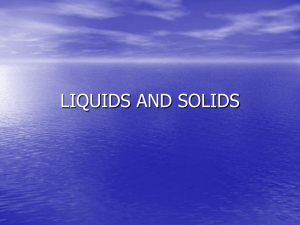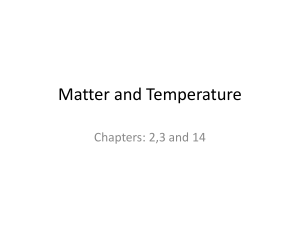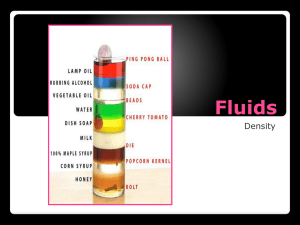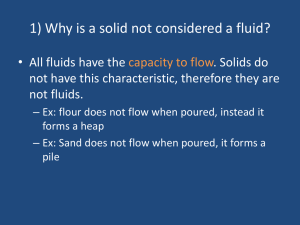Liquids and Solids
advertisement
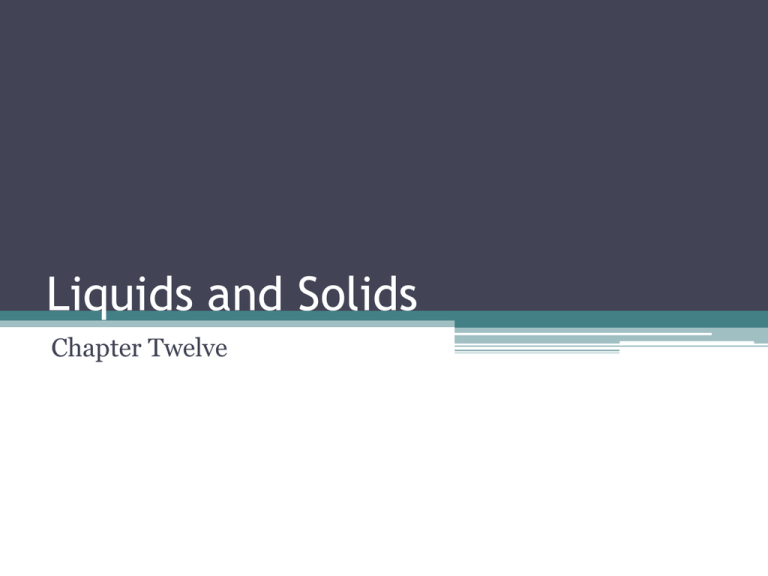
Liquids and Solids Chapter Twelve Liquids and Kinetic Molecular Theory • form of matter w/definite volume and shape of container • particles in constant motion; closer together and lower in KE than gases • attractive forces more effective than in gases; forces are intermolecular: dipole-dipole, London Dispersion, and Hydrogen-bonding • more ordered than gases, but particles are not in fixed positions Fluid • a substance that can flow and therefore take the shape of its container • most flow downhill because of gravity • Helium near 0 Kelvin is able to flow uphill Relatively High Density • most liquids are thousands of times denser than gases • result of close arrangement of particles • most only slightly less dense as liquids than as solids • water one of few that becomes less dense as a solid Other properties: • Relative Incompressibility ▫ much less compressible than gases (particles packed closer together) ▫ can transmit pressure equally in all directions • Ability to Diffuse ▫ can diffuse and mix w/any other liquid in which it can dissolve ▫ much slower than gases – attractive forces impede movement ▫ w/increase in temp, diffusion occurs more rapidly Surface Tension • a force that tends to pull adjacent parts of a liquid’s surface together, thereby decreasing surface area to the smallest possible size • property of all liquids • higher forces of attraction = high surface tension; water higher than most -causes droplets to have a spherical shape Capillary Action H2O • the attraction of the surface of a liquid to the surface of a solid • rise high in tube w/strong attraction; goes till weight of liquid = gravitational force • responsible for transportation of water from roots to leaves Hg -capillary action is responsible for the concave liquid surface, or meniscus, which forms in a test tube or graduated cylinder Important Terms • Vaporization – process by which a liquid or solid changes to a gas • Evaporation – a form of vaporization; the process by which particles escape from the surface of a non-boiling liquid and enter the gas state • Boiling – the change of a liquid to bubbles of vapor that appear throughout the liquid More terms: • Formation of solids – cooling decreases energy of particles. If low enough, attractive forces pull particles into more orderly arrangement: a solid • Freezing – the physical change of a liquid to a solid by removal of heat; also called solidification • Sublimation – solid directly to gas (dry ice) • Deposition – gas directly to solid (frost) Solids and KM Theory • more closely packed; intermolecular forces more effective • forces hold particles in fixed positions – only vibrational movement around fixed point • more ordered than liquids; much more ordered than gases Two Types of Solids • Crystalline – most solids; they consist of crystals • Crystal – a substance in which the particles are arranged in an orderly, geometric repeating pattern • Amorphous – one in which the particles are arranged randomly Definite Shape and Volume • maintain definite shape w/o container • crystalline solids are geometrically regular; even the fragments have distinct shapes • amorphous solids maintain shape but don’t have distinct geometric shapes • volume changes only slightly w/temp change • crystalline solids do not flow Definite Melting Point Melting – the physical change of solid to liquid by adding heat Melting point – the temp at which a solid becomes a liquid -KE of particles overcome attractive forces -amorphous solids don’t have definite melting pt; flow over range of temps Supercooled liquids (amorphous solids) – are substances that retain certain liquid properties even at temp at which they appear to be solid High Density and Incompressibility • Substances most dense in solid state; slightly more than liquids; much more than gases • Solid hydrogen is least dense solid; osmium densest element • Considered incompressible Low Rate of Diffusion -diffusion does occur -rate is million times slower than in liquids Crystalline Solids -exist as single crystals or groups of crystals fused together Crystal structure – the 3-D arrangement of particles of a crystal -can be represented by coordinate system called a lattice Unit Cell – smallest portion of a crystal lattice that shows the 3-D pattern of the entire lattice Four Types of Crystals 1. Ionic crystals - positive and negative ions arranged in regular pattern -ions can be monatomic or polyatomic -hard and brittle; high melting points; good insulators NaCl unit cell 2. Covalent network crystals -sites contain single atoms covalently bonded to nearest neighbors -extends thru very large # of atoms -always very hard and brittle; high melting points; usually non-conductors or semi-conductors 3. Metallic crystals -metal atoms surrounded by sea of e-freedom of outer-structure e- to move explains high electric conductivity: these crystals have varying melting points 4. Covalent molecular crystals -covalently bonded molecules held together by intermolecular forces -nonpolar have only weak London dispersion forces -polar held together by dispersion forces, somewhat stronger dipole-dipole forces, and sometimes by stronger H-bonding -low melting points; easily vaporized; soft; good insulators Amorphous Solids • from “without shape” • don’t have regular, natural shape; take on imposed shape • hold shape for a long time; flow but very slowly • glasses are example: molten materials cooled so they don’t crystallize but remain amorphous Structure of Water 2 atoms of H and one of O united by polar-covalent bonds -in bent shape, angle between 2 bonds is about 105 -molecules in solid or liquid are H-bonded -w/o hydrogen bonding, water would be a gas at room temp Water as a Solid -ice consists of H2O molecules in hexagonal arrangement -empty spaces between molecules account for low density - when heated, increased KE causes molecules to vibrate more vigorously; when melting pt is reached the rigid open structure of the ice crystal breaks down and the ice turns to liquid -once rigid structure has broken down, H2O molecules crowd closer together, liquid H2O is denser than ice Increasing KE • as liquid H2O is warmed from 0C the molecules crowd even closer; they are as tightly packed as possible at 3.98 C • from that temp the molecules move further apart as temp increases • because of H-bonding, a high KE is required to break the bonds causing H2O BP to be high compared to other liquids w/similar masses Physical Properties of Water • transparent, odorless, tasteless, almost colorless at room temp • Freezes at pressure of 1 atm and melts at 0C • expands in volume as it freezes • ice floats in water • insulating effect of floating ice is particularly important in the case of large bodies of H2O • at pressure of 1 atm water boils at 100C • BP is quite high compared w/that of nonpolar substances of comparable mass • values are high because of strong H-bonding Thermochemistry • Study of the transfers of energy as heat that accompany chemical reactions and physical changes • All chemical reactions are accompanied by a change in energy • Usually absorb (endothermic) or release (exothermic) energy as heat Calorimeter -instrument for measuring the energy absorbed or released as heat in a chemical or physical change -data collected are temp changes because heat cannot be measured directly; but temp, which is affected by the transfer of energy as heat, is directly measurable Temperature • The measure of the average kinetic energy of the particles in a sample of matter • The greater the kinetic energy, the higher the temp, and the hotter it feels • Measured in °Celsius or Kelvins Joule (J) -the SI unit of heat as well as all other forms of energy -measures the amount of energy transferred as heat A joule is relatively small so the kilojoule, kJ, is commonly used Heat -the energy transferred between samples of matter because of a difference in their temperatures -energy moves spontaneously from higher to lower temp; when the temps are equal, energy is no longer transferred Heat Capacity -the quantity of energy transferred as heat depends on the nature of the material changing temp, the mass changing temp, and the size of the temp change -a quantity called specific heat can be used to compare heat absorption capacities for different materials Specific Heat Definition: the amount of energy required to raise the temperature of one gram of substance by one Celsius degree or one Kelvin Finding specific heat: cp Specific heat is measured in J/g K (and is under constant pressure) = q m T Mass in grams Energy in Joules Change in temp in ºC or K You will frequently see this equation written q (or Q) = cpmT which is the way it appears on the TAKS formula chart. As written, the equation is being solved for energy in J rather than specific heat. Change in temperature can be either Celsius or Kelvin as the magnitude of the change is equal for either.
